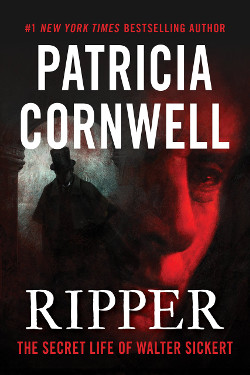 Ripper: The Secret Life of Walter Sickert by Patricia Cornwell is a comprehensive and intriguing exposé of one of the world’s most chilling cases of serial murder—and the police force that failed to solve it (available February 28, 2017).
Ripper: The Secret Life of Walter Sickert by Patricia Cornwell is a comprehensive and intriguing exposé of one of the world’s most chilling cases of serial murder—and the police force that failed to solve it (available February 28, 2017).
In 2001, acclaimed crime novelist Patricia Cornwell stepped away from fiction to investigate the facts and fallacies surrounding London’s infamous Jack the Ripper killings. The book that followed, Portrait of a Killer (2002), identified British painter Walter Sickert as the culprit—and earned Cornwell widespread derision among so-called Ripperologists. Fifteen years later, she returns with Ripper: The Secret Life of Walter Sickert—a revised and expanded edition of her earlier work, featuring eight new chapters, detailed maps, and hundreds of images that further illuminate her case.
Cornwell—internationally recognized for her novels featuring medical examiner Dr. Kay Scarpetta, who most recently appeared in Chaos (2016)—is credited with popularizing the forensic thriller, and she continues to research advanced scientific principles for use in her books. She applies these same techniques in pursuit of the Ripper; in addition to the countless hours required for investigation and travel, she also invested millions of dollars of her own money in her search for truth.
Consequently, her case against Sickert includes DNA testing (the swabbing of Sickert and Ripper-related envelopes and stamps), forensic analysis (the matching of paper and watermarks between Sickert and Ripper letters), and handwriting inspection (comparisons between Sickert’s personal correspondence and Ripper letters). And while the results are somewhat limited, or even inconclusive, individually—not surprising, given the passage of time, the antiquated means of evidence collection and study, and the contamination and/or disappearance of evidence—the resulting portrait is extremely compelling when considered in its totality.
Beyond physical evidence, Cornwell delves deeply into Walter Sickert’s psyche, presenting him as a Jekyll-and-Hyde-like character, both charming and conceited. She argues that this duplicity of nature is rooted in childhood trauma; Sickert underwent repeated and excruciating surgeries for a fistula (whether it was of the anus or penis remains unknown) that could have left him impotent—or, at the very least, may have made sexual intercourse painful and/or dysfunctional.
Sickert also had indifferent parents, rival siblings, and a contentious relationship with his mentor, artist James Whistler, whose engagement and subsequent marriage may have proved an impetus for the killings. Further, Cornwell cites Sickert’s background as an actor and his fondness for disguises (she refers to him as a “chameleon”) as being consistent with the perpetrator’s actions; both would have aided the Ripper in evading detection and capture. And finally, she demonstrates how Sickert’s paintings and other artwork bear potentially incriminating clues.
While Cornwell exhaustively vets Sickert’s life and art, she also pays respect to the Ripper’s victims (“The Unfortunates”), not only by reexamining the circumstances of their brutal deaths, but also by illuminating the context of their lives. Indeed, one of the most grounding aspects of this work is her portrayal of the socioeconomic factors influencing day-to-day living in 1880s London; while the five deaths attributed to the Ripper were often downplayed due to the victims’ status as prostitutes, the author humanizes them—and reminds us that they deserve justice, no matter how delayed.
It’s also worth noting that Cornwell convincingly argues the Ripper claimed many more victims—including both adults and young children—by virtue of transience and an ever-changing MO. These cases, though equally cold, were largely dismissed due to their superficial differences and a widespread desire to allow the Ripper to fade into oblivion.
In terms of purely aesthetic consideration, Ripper is a pleasing publication. The paper is of exceptionally good quality, there is color printing peppered throughout, and the sheer wealth of imagery and illustrations—which include but are not limited to, rare crime scene and autopsy photos, Sickert’s art, and the Ripper’s various letters and doodling—is both impressive and immersive. The cumulative effect is one of style and substance that’s hard to ignore.
A final noteworthy aspect is the inclusion of the content that comprised the author’s previously published Kindle Single, Chasing the Ripper (2014). In these pages, Cornwell reveals her personal motivations and struggles (including the unusual phenomena plaguing her investigation); it’s a rare, unvarnished look at the author’s process, and it shows that she may be at her very best when assessing her own life’s work.
While Ripper will undoubtedly prove divisive among experts (and amateur detectives), it’s a groundbreaking revisitation of one of history’s most notorious and hotly debated unsolved mysteries. Patricia Cornwell’s knowledge of criminology and forensics is near unrivaled, and her passionate and informed narration—told with unwavering conviction—may just tip the scales of justice once and for all.
See also: Review: Chaos by Patricia Cornwell
To learn more or order a copy, visit:
John Valeri wrote the popular Hartford Books Examiner column for Examiner.com from 2009 – 2016. He can be found online at www.johnbvaleri.com and is featured in the Halloween-themed anthology Tricks and Treats, now available from Books & Boos Press.

OMG! I’m so excited about this book! I consider myself a budding Ripperologist. Did I spell that right? Anywhoo, thanks for sharing ’cause I’ll be reading!!!!
After the proclamation on Sunday, Prime Minister Anthony Albanese said this was a time to pay respect and tributes to the life of the Queen. The bigger constitutional questions are to be tackled later.